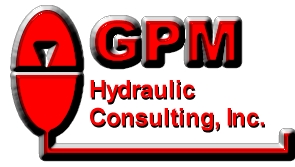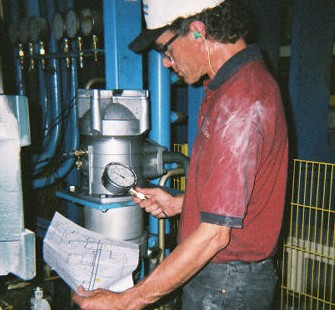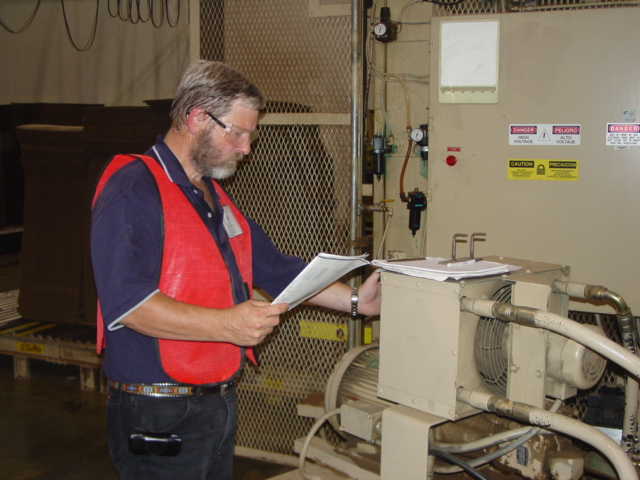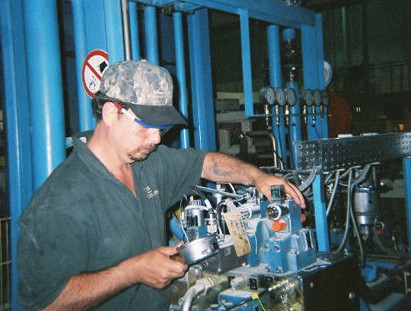
P.O. Box 1376
Monroe, GA 30655
(770) 267-3787
gpm@gpmhydraulic.com
 |
 |
 |
 |
 |
 |
For an archive of past newsletters, please visit:
http://www.GPMHydraulic.com/newsletter_archive/
"Troubleshooting Hydraulics" Newsletter
www.gpmhydraulic.com
Click Here to view a brief video about our 3-day workshop
1. Aeration and Cavitation - What is the difference?
2. Call GPM For Emergency Troubleshooting
3. The Six Most Costly Mistakes in Hydraulic Systems
4. Is It Time For A Hydraulic Reliability Assessment At Your Plant?
5. Take the Quiz!
6. 2013 Hands-On Public Reliability & Troubleshooting Workshops
I find a lot of confusion among maintenance professionals concerning aeration and cavitation. Many do not understand the difference between the two. This is not surprising - they can often sound similar. But they are in fact two entirely different problems - and with entirely different solutions.
Cavitation is the formulation and collapse of air cavities in the liquid.
Aeration is the result of outside air entering the suction side of the pump.
Cavitation results when the pump attempts to deliver more oil than it can get into its suction. Hydraulic oil has a significant amount of dissolved air - 6-12% by volume. A number of factors can determine how much air becomes dissolved - the oil temperature, additives, the level of other comtaminants and the oil pressure to name a few. When the inlet flow becomes lower than the flow the pump tries to deliver, suction pressure becomes very low and some of the air molecules are extracted from the oil. As this occurs, the air molecules implode inside the pump. The symptom is a very steady high-pitched whining sound. If this continues unchecked, the pump will, of course, deliver a reduced flow (obviously - since the pump can deliver no more flow than can enter) and will eventually destroy itself. This is one reason the suction port is typically larger than the pressure port, to keep suction velocity low so that it is easy for oil to enter. Anything that can restrict oil from entering the pump suction line can cause cavitation. If the oil is too cold, the viscosity will increase and the amount of oil that can enter the suction port will be decreased. In general, most machines should not be powered up unless the oil is at least 40o F. It should not be placed under load until the oil temperature is at least 70o F.
The most common cause of cavitation is a plugged suction strainer or filter. Suction strainers are inside the reservoir below the level of the oil. They are out of sight and out of mind. If it is not someone's job to periodically inspect and clean suction strainers, there is likely to be pump damage.
An undersized or clogged breather cap can cause a pump to cavitate. The reservoir needs to breathe because it requires more oil to extend a cylinder than to retract it. The oil level goes up and down throughout the cycle of the machine. If it's hard for air to get in, the pump has to work harder and suction pressure drops easily.
Turbulence caused by suction isolation valves can be another culprit as can an excessive vertical distance between the pump suction port and the minimum fluid level.
There are those who believe that, if a pump cavitates, it must be replaced. Often when the pump IS replaced, the cause of the cavitation is corrected, reinforcing this notion. The fact is, if a pump is strong enough to cavitate, it is probably strong enough to do its job. Of course, if it is allowed to cavitate for very long, it most certainly WILL need to be replaced.
Aeration has a much more erratic sound than cavitation. It is usually accompanied by a sound similar to marbles or gravel rattling around inside the pump. And if you can see the oil in the reservoir, you will often see foaming. Anything that can allow air into the suction line can cause aeration. When air enters the suction line, a number of problems are caused. Among them are spongy component response, reduced viscosity (and the subsequent compnent wear), increased temperature (because of the reduced thermal conductivity) and severe fluid degradation which will lead to damage from poor lubrication, overheating and burning of seals.
A leak in the suction line is one common cause of aeration. The pressure in the suction line is below that of atmospheric pressure so oil doesn't leak out - air leaks in. If you suspect an air leak, squirt oil up and down the suction line. If it stops aerating, you found your leak.
A bad shaft seal on a fixed displacement pump can cause aeration. To test the shaft seal, spray shaving cream around it. If the shaft seal is bad, holes will be drawn into the shaving cream as air enters the pump.
A low fluid level will cause a vortex to develop over the suction strainer - much the same as draining your bathtub. Both air and oil enter the suction line and aeration occurs.
Misaligned couplings also can let air into the suction line. Make sure couplings are properly aligned and torqued. Don't forget ball valves and gate valves in the suction line. They can leak, too. Prevention is always better than the cure and spotting aeration or cavitation early is simply a matter of paying attention to the sounds your machine makes.

As the suction pressure decreases, static pressure increases. The result is the implosion of dissolved air molecules in the oil. This implosion causes a jet to form, directing force to the metal and eroding it..

The pitting shown above is the result of metal erosion by cavitation.

The heat-checked inner surface of the vane pump cam ring above is symptomatic of an aerated inlet.

 |  |  |
Nothing is more expensive than unscheduled down time. GPM’s customers know they can call whenever they have a troubleshooting issue they simply can’t resolve. With over 75 years' experience dealing with hydraulic failures, our consultants have the resources to help troubleshoot whatever hydraulic problem you encounter. Whether you’re experiencing a total system outage, repeated component failure or need a professionally designed hydraulic reliability assessment, the consultants at GPM can help. Call GPM for:
- In-plant Troubleshooting
- Leakage Problems
- Pressure Settings
- Shock Problems
- Hydraulic Reliability Assessments
- Hydraulic Troubleshooting Manual Development
- Startup Consulting and Recommendations
- Heat Problems
- Repeated Component Failures
- Speed Problems
Do you want to learn more about how GPM can help you? Go to http://gpmhydraulic.com/troubleshooting.php.
Also, I conducted a site survey for another papermill in Eastover, SC. It consisted of hydraulic system verification for developing a customized hydraulic troubleshooting manual. While at the GPM headquarters, I have been working on the technical writing and drafting for the Eastover manual as well as manual development for a papermill in Vicksburg, MS. In between all the work related travel, I took some time to visit with the grandkids in Maryland.This was just a few of many backroads my personal and GPM travels carried me in the months of May and June of this year. |
||
2 tablespoons freshly ground black pepper |


